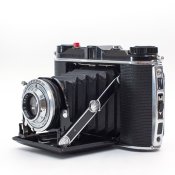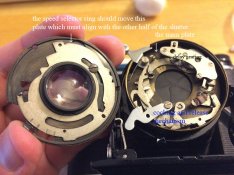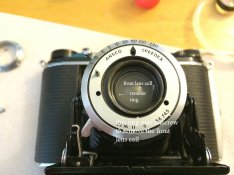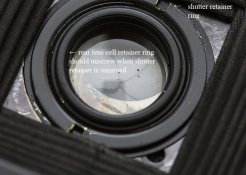rogueguineapig
Member
- Joined
- Mar 1, 2015
- Messages
- 8
- Format
- Medium Format
Hey folks,
sometime lurker, first time poster here.
My uncle gave me an Ansco Speedex, which is in pretty decent shape. The bellows only have one small pin hole which I think
can be repaired easily. Additionally, the shutter and cocking mechanism work like a charm.
On the other hand... the focus ring was frozen, and I managed to dissemble it and then get a lot of the Agfa green goop out.
The focus ring now works.
The dissembly of the whole thing was quite messy, but I did get it back together....I did it from the front, which gave me access to the
shutter mechanism, but not the aperture.
In the process of letting some goo-gone seep into the lens assembly, I got the aperture selector loose...and that's when the trouble started.
I was able to move the little pointer, but then the aperture iris partially froze, leaving it in the state as seen in the pix below. Moving it around
made no change...the aperture is only partially working.
Additionally, I cannot get the silver outer ring (which controls shutter speed?) to move. It's frozen solid. Or maybe I'm trying to actuate the wrong thing!
Anyway... anyone have any experience or advice with these? I'd love to try this bad boy out as a broke student, but I'm
not sure it can be salvaged, and from eBay prices I can kind of surmise that paying for a pro repair job isn't really worth it.
My uncle bought it as a shelf-queen for kicks, so it's not heavily laden with sentiment, but I'd still like to use it.
Pix below, any ideas, comments, or suggestions appreciated.
Thanks!




sometime lurker, first time poster here.
My uncle gave me an Ansco Speedex, which is in pretty decent shape. The bellows only have one small pin hole which I think
can be repaired easily. Additionally, the shutter and cocking mechanism work like a charm.
On the other hand... the focus ring was frozen, and I managed to dissemble it and then get a lot of the Agfa green goop out.
The focus ring now works.
The dissembly of the whole thing was quite messy, but I did get it back together....I did it from the front, which gave me access to the
shutter mechanism, but not the aperture.
In the process of letting some goo-gone seep into the lens assembly, I got the aperture selector loose...and that's when the trouble started.
I was able to move the little pointer, but then the aperture iris partially froze, leaving it in the state as seen in the pix below. Moving it around
made no change...the aperture is only partially working.
Additionally, I cannot get the silver outer ring (which controls shutter speed?) to move. It's frozen solid. Or maybe I'm trying to actuate the wrong thing!
Anyway... anyone have any experience or advice with these? I'd love to try this bad boy out as a broke student, but I'm
not sure it can be salvaged, and from eBay prices I can kind of surmise that paying for a pro repair job isn't really worth it.
My uncle bought it as a shelf-queen for kicks, so it's not heavily laden with sentiment, but I'd still like to use it.
Pix below, any ideas, comments, or suggestions appreciated.
Thanks!





















